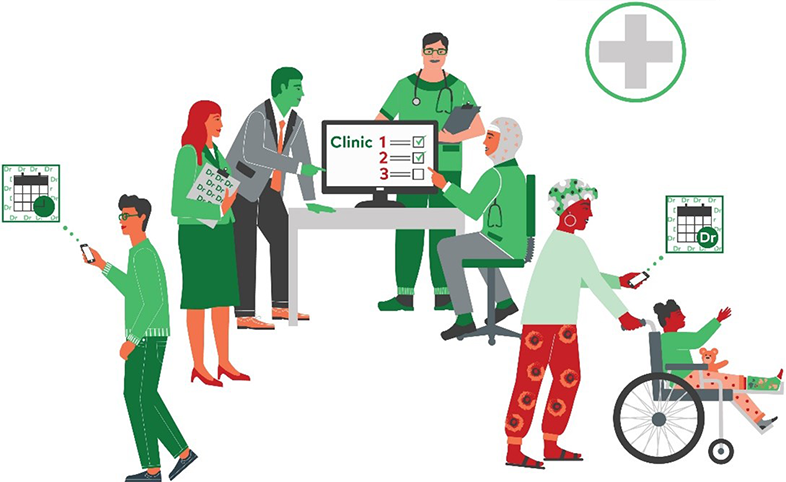Dr Simon Rudland (Chair Suffolk GP Federation; Visiting GP Hoy and Walls Practice Orkney; Honorary Senior Lecturer and Digital Health Lead, Norwich Medical School) and Dr Sarah Robinson (Director of Delivery, Health Innovation East).
Covid-19 has been a driver of innovative practice at speed across the healthcare system which should be celebrated. In all sectors there has been a shift to remote care and primary care has adopted a proliferation of new tools, at pace, to enable online triage, delivery of care and video consultations. However, the pandemic and the pre-existing digital divide made it particularly difficult for some sectors of our communities to access primary care. This has become a more significant problem, one year into the pandemic and when the short-term digital solutions to manage shielding and infection control are becoming embedded practice.
eConsulting – staff perspectives
Some primary care practices had been operating an eConsulting model, which means many of their patients interact digitally with the practice prior to the Covid-19 pandemic. Others moved very swiftly, in just a few weeks, to adopt technology and rollout a virtual service to patients that would also enable staff to work in a safe and effective fashion. From a survey* we undertook in May 2020 with primary care staff in Suffolk there was a broad endorsement of the rapid change to digital methods among GPs – specifically one in three GP respondents supported remote consultations, triage tools to enable access to care for those in need and the use of solutions to access clinical systems remotely.
However, using remote consultation as a first option was only endorsed by only a minority of GPs (23%) with 26% saying they would do fewer remote consultations or stop them entirely in the future. The reasons given for this included that these consultations can take more time and that patients should be seen face-to-face unless a patient chooses otherwise, or there is a good reason to the contrary. Eight clinical staff (17%) also shared their concerns about patients not accessing healthcare services, an over-reliance on virtual consultations and the lack of proactive long-term management that was occurring.

eConsulting – patient perspectives**
Generally, patients have valued being triaged quickly and a reduced need to visit their surgery. Continuity of care particularly for ongoing episodes of care is highly valued. Online technologies are perceived to have improved access and convenience of access to health professionals.
However, it is important to also reflect on the impact of those who have required healthcare expertise but avoided seeking it for fear of catching Covid-19. A theme in the primary care survey was that 17% primary care staff reported their concerns about patients not seeking their services during the pandemic. Not all patients are happy to contact surgeries online and attendance at surgeries for non-Covid-19 issues has been predictably difficult for some patients. Notably, some vulnerable groups, such as the homeless, have experienced even greater difficulties in accessing services.
What next for GP leaders?
- Engaging the primary care workforce: Meeting patient’s needs will be highly dependent on a functioning resilient workforce who are engaged with new ways of working. The difficulties faced by fatigued clinicians have been highlighted (Mathew, 2021). The temptation to slip back into pre-pandemic parochial thinking must be resisted and we should look to lever advantages for workforce stability from working at scale.
- Empower and engage with the public: The voices of people in our community, particularly those with long term conditions, mental health problems and hard to reach groups can be heard through the co-production of solutions (Richardson and Scowcroft, 2020) and collaboration with social care and the private sector. This is critically important as digital exclusion is more likely to affect people in lower income groups, people in social housing, people with disabilities, mental health problems, homeless people, and people whose first language is not English (NHS Digital, 2021). Digital exclusion is often linked with social exclusion and therefore impacts the wider determinants of health.
- Continue collaboration and working at scale: Primary Care Networks have led to the emergence of clinical leaders who realise that collaboration and working at scale, are essential for the delivery of primary care now and in the future. These themes are echoed in the future of health care white paper (GOV.UK , 2021) which anticipates greater integration between the NHS and social care. It is anticipated that better use of digital technology will form an important component of these changes.
- Consider the changes in workflow and demand: the necessary focus of staff on responding to the pandemic and vaccination campaigns has led to a backlog of specialist referral and procedures (Griffin S, 2020) and previously readily available investigations such as X-ray, open access CT or endoscopy are limited. Digital tools can support both managed demand and direct patient requests to ensure needs are fulfilled by the most appropriate team member in accordance with capacity. A demand-led service model understands what the demand is, recognises that it is consistent and predictable and ensures that the service provision is designed to match.
- Consider the well-being and resilience of the primary care workforce: There is an emerging conflict for GP leaders, on one hand they are more empowered to change working practices to support well-being, on the other hand, they are bound by the increased demand being placed on primary care in recovery from the pandemic. Due to their independent contractor status, this vital part of the NHS workforce are not routinely considered within national NHS well-being programmes.
Digital forms of consultation are not a panacea across all sections of the population – practices will need to consider who they are not enabling to access services through the promotion of digital first approaches.
If you want faster access to the latest innovations and technologies to help deliver excellent patient care, get in touch.
*Ipswich and East Suffolk Clinical Commissioning Group (IESCCG) ran a survey of all primary care staff in Suffolk during May 2020. 72 responded: 35 GPs, 13 managers, 13 nurses and 11 others, including paramedics, Physician Associates and mental health workers. The survey was accompanied by conversations during May and June 2020 with 12 primary care leaders in Cambridgeshire, Essex, Norfolk, and Suffolk who it was thought would provide a good insight into changes in primary care.
**The patient perspective has primarily been informed by a conversation with Healthwatch Suffolk who have shared the essence of relevant comments received at their feedback centre.
References
- Mathew, R., 2021. Rammya Mathew: Workforce must be at the centre of covid-19 recovery plans. BMJ, p.n635.
- Richards T, Scowcroft H. Patient and public involvement in covid-19 policy making. BMJ. 2020; m2575.
- Topol, E., 2019. Preparing the healthcare workforce to deliver the digital future. [online] Topol.hee.nhs.uk. Available at: <https://topol.hee.nhs.uk/wp-content/uploads/HEE-Topol-Review-2019.pdf> [Accessed 23 July 2019].
- NHS Digital. 2021. Definition of Data Inclusion [online] Available at What we mean by digital inclusion – NHS Digital
- Griffin, S., 2020. Covid-19: Waiting times in England reach record highs. BMJ, p.m3557.
- UK. 2021. The future of health and care. [online] Available at: <https://www.gov.uk/government/speeches/the-future-of-health-and-care> [Accessed 15 March 2021].
You may also like…
Share your idea
Do you have a great idea that could deliver meaningful change in the real world?
Get involved

